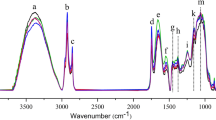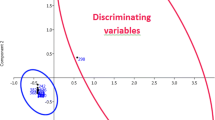Abstract
This work aimed to classify the categories (produced by different processes) and brands (obtained from different geographical origins) of Chinese soy sauces. Nine variables of physico-chemical properties (density, pH, dry matter, ashes, electric conductivity, amino nitrogen, salt, viscosity and total acidity) of 53 soy sauce samples were measured. The measured data was submitted to such pattern recognition as cluster analysis (CA), principal component analysis (PCA), discrimination partial least squares (DPLS), linear discrimination analysis (LDA) and K-nearest neighbor (KNN) to evaluate the data patterns and the possibility of differentiating Chinese soy sauces between different categories and brands. Two clusters corresponding to the two categories were obtained, and each cluster was divided into three subsets corresponding to three brands by the CA method. The variables for LDA and KNN were selected by the Fisher F-ratio approach. The prediction ability of all classifiers was evaluated by cross-validation. For the three supervised discrimination analyses, LDA and KNN gave 100% predications according to the sample category and brand.
Similar content being viewed by others
References
Pizarro C, Esteban-Diez I, Saenz-Gonzalez C, Gonzalez-Saiz JM. Vinegar classification based on feature extraction and selection from headspace solid-phase microextraction/gas chromatography volatile analyses: a feasibility study. Anal Chim Acta, 2008, 608(1): 38–47
Yamaguchi N, Fujimaki M. Studies on browning reaction products from reducing sugars and amino acid: part 14. Antioxidative activities of purified melanoidin and their comparison with those of legal antioxidants. J Food Sci Technol, 1974, 21: 6–12
Kataoka S. Functional effects of Japanese style fermented soy sauce (shoyu) and its components. J Biosci Bioeng, 2005, 100(3): 227–234
Masino F, Chinnici F, Franchini GC, Ulrici A, Antonelli A. A study of the relationships among acidity, sugar, and furanic compound concentrations in set of casks for Aceto Balsamico Tradizionale of Reggio Emilia by multivariate techniques. Food Chem, 2005, 92(4): 673–679
Lachman J, Kolihova D, Miholova D, Kosata J, Titera D, Kult K. Analysis of minority honey component: possible use for the evaluation of honey quality. Food Chem, 2007, 101(3): 973–979
Angeles Herrador M, Gustavo Gonzalez A. Pattern recognition procedures for differentiation of Green, Black and Oolong teas according to their metal content from inductively coupled plasma atomic emission spectrometry. Talanta, 2001, 53(6): 1249–1257
Casale M, Armanino C, Casolino C, Forina M. Combining information from headspace mass spectrometry and visible spectroscopy in the classification of the Ligurian olive oils. Anal Chim Acta, 2007, 589(1): 89–95
Inon FA, Garrigues S, Guardia M. Combination of mid- and near-infrared spectroscopy for the determination of the quality properties of beers. Anal Chim Acta, 2006, 571(2): 167–174
Baeten V, Dardenne P, Aparicio R. Interpretation of Fourier transform Raman spectra of the unsaponifiable matter in a selection of edible oils. J Agric Food Chem, 2001, 49(11): 5098–5107
Zhang GW, Ni YN, Churchill J, Kokot S, Authentication of vegetable oils on the basis of their physico-chemical properties with the aid of chemometrics. Talanta, 2006, 70(2): 293–300
Masino F, Chinnici F, Bendini A, Montevecchi G, Antonelli A. A study on relationship among chemical, physical, and qualitative assessment in traditional balsamic vinegar. Food Chem, 2008, 106(1): 90–95
Zhang L, Lu ZY, Li SQ, Yue Y. Fermented vinegar. Beijing: Chinese Standards Press, 2000
Ding XY, Hu KQ, Zhong GS, Zhu H, Bai XG. Method for analysis of hygienic standard of soybean sauce. Beijing: Chinese Standards Press, 2003
Gao XW, Yang HR, Wu YX, Lv GF. Determination of ash in foods. Beijing: Chinese Standards Press, 2003
Geladi P. Kowalski BR. Partial least-squares regression: a tutorial. Anal Chim Acta, 1986, 185: 1–17
Hartigan JA. Clustering algorithms. New York: Wiley, 1975
Malinowski ER. Factor Analysis In Chemistry. 3rd ed. New York: John Wiley & Sons, 2002
Jolliffe IT. Principal Component Analysis. New York: Springer-Verlag, 1986
Coomans D, Jonckheer M, Massart DL, Broeckaert I, Blockx P. The application of linear discriminant analysis in the diagnosis of thyroid disease. Anal Chim Acta, 1978, 103: 409–415
Massart DL, Vandeginste BGM, Deming SN, Michotte Y, Kaufman L. Chemometrics: A Textbook. Amsterdam: Elsevier Science Publishers, 1988. 395–397
Goutte C. Note on free lunches and cross-validation. Neural Comput, 1997, 9(6): 1245–1249
Berrueta LA, Alonso-Salces RM, Heberger K. Supervised pattern recognition in food analysis. J Chromatogr A, 2007, 1158(1–2): 196–214
Sharaf MA, Illman DL, Kowalski BR. Chemometrics. New York: John wiley & Sons, 1986
Fernandez-Torres R, Perez-Bernal JL, Bello-Lopez MA, Callejon-Mochon M, Jimenez-Sanchez JC, Guiraum-Perez A. Mineral content and botanical origin of Spanish honeys. Talanta, 2005, 65(3): 686–691
Marini F, Magri AL, Balestrieri F, Fabretti F, Marini D. Supervised pattern recognition applied to the discrimination of the floral origin of six types of Italian honey samples. Anal Chim Acta, 2004, 515: 117–125
Varmuza K. Pattern Recognition In Chemistry. Heideberg. Springer Verlag, 1980
Author information
Authors and Affiliations
Corresponding author
Rights and permissions
About this article
Cite this article
Chen, Y., Ni, Y. & Kokot, S. Discrimination of Chinese traditional soy sauces based on their physico-chemical properties. Sci. China Chem. 53, 1406–1413 (2010). https://doi.org/10.1007/s11426-010-3163-4
Received:
Accepted:
Published:
Issue Date:
DOI: https://doi.org/10.1007/s11426-010-3163-4




